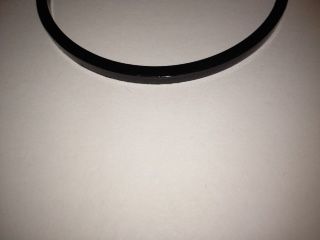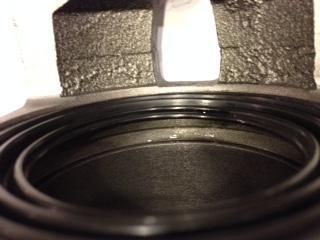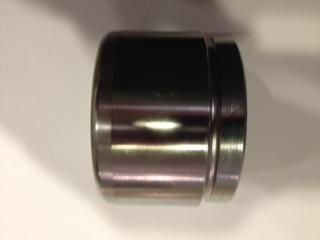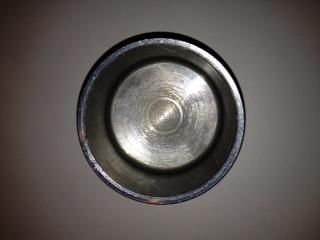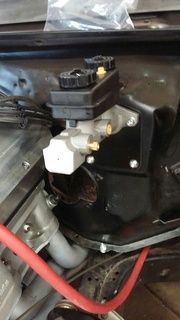I am done testing the manual brake setup with a stock, aluminum, rebuilt, 24mm bore, 1980 El Camino master cylinder. With only this change, I got back the brake fluid pressure that I lost when I upgraded to the Wilwood 2.75” metric calipers using the 7/8” bore master cylinder. I bench bleed the master cylinder installed it in place of the 7/8” bore master cylinder, bled the line at the master cylinder, and then bled the car at all four wheels.
On the test drive, using the 24mm master, I did a few hard stops from about 30 mph. I was rewarded with both rear wheels locking up, but the front braking system felt as if it still wasn’t grabbing. After the testing, I jacked the front of the car and removed the wheels and I unbolted the calipers so I can take a look at the pads. I suppose during my very first manual brake test, I did not bed the brakes in properly and I glazed the brake pads over. I do not know why I did not notice this when I put on the Wilwood calipers other than not recognizing what glazed pads look like. The glazing most likely happened because I had a large master cylinder and small calipers on my first manual brake test and, at the time, I wasn’t getting enough pressure to the pads to do accomplish correct bedding. The moral of the story is to bed your pads properly.
Good news is that I found out what the issue is with the front brakes not grabbing. Bad news is that I didn’t deglaze my pads and retest. I didn’t deglaze the pads I originally used because went ahead and upgraded to a Wilwood Polymatrix A brake pad.
I went to the Wilwood PolymatrixA pad because of its good, cold clamping properties and, before I realized about the glazing pads, I had thought this would help with front brakes. **As a warning from Wilwood to any one using these pads, Wilwood considers these race pads**. These are aggressive pads and will most likely wear the front rotors prematurely and are intended for race use only. These pads have almost twice the friction coefficient as a “stock” type pad. I am using this aggressive pad because the front rotors are small, the brake pads are small, the front calipers are a floating design, and the car is now has manual brakes. These pads are also a wallet buster at $150 a set.
The braking test with these pads where a noticeable night a day difference. I felt very comfortable and confident while driving and stopping. On hard stops, the nose of the car would “dive” down and the rear wheels still locked up. Only time will tell if these front pads are good for everyday use with this manual brake setup.
If your car is a daily driver and not a drag car, you most likely do not need to change out to larger wheel cylinders on the rear drum brakes like I did. The original stock 3/4” bore wheel cylinders versus the larger 7/8” bore wheel cylinders should reduce rear lock up on hard braking.
For a drag racer with large, wide, sticky tires on the back, the larger 7/8” bore wheel cylinder may be better to keep the rear tires from spinning when your holding the car on the line with just the brakes. An aggressive front pad may also be needed to hold the car on the line (contact one of the major brake pad manufactures for suggestions).
From my experience, to do a manual brake system on a g-body or s-10, some or all of the brake components will have to be replaced. You cannot just remove the vacuum booster and bolt the master cylinder to the firewall and expect your braking to function well. It is a system approach.
Do you need an oversized caliper? In my opinion, no you do not.
Do you need to change out the front calipers? In my opinion, yes you do. Why? Because the stock calipers may or may not be a LOW DRAG design which requires a step bore master cylinder. How do you know that you have LOW DRAG calipers? You actually cannot physically tell, so its best to buy aftermarket calipers to cut down on variables that may cause trouble with your braking system.
Do I recommend rebuilt front calipers from the auto parts store? No. See above.
Do you need to change out the master cylinder? In my opinion, most likely you will need to. Why? It depends on what you are starting with. If you have a GM g-body vehicle that was built from 1978 to 1980, you have a strait bore, 24mm bore master cylinder from the factory and you can just upgrade to Wilwood 2.75” bore calipers if you master cylinder is in good working order. If you have a vehicle built from 1981 through 2003 you most likely have a step bore master cylinder. These master cylinders are too large for almost all manual brake conversions on a g-body or s-10. Now a choice has to be made. How much money do you want to spend on aftermarket front calipers? Cheapest ones that I have found are around $45 each with a stock size bore from U.S. Brakes. You will then need a 7/8” bore master cylinder to match to these front calipers. For a g-body car you can go with a new or rebuilt, stock replacement from a 1978 to 1980 g-body manual brake master cylinder. For an S-10, the only option I have found that readily bolts to the firewall and to the brake lines is a Wilwood 7/8” bore master cylinder. If upgrading to the Wilwood 2.75” bore calipers, you will need a 24mm master cylinder. The g-body options are a new or built stock power brake unit from a 1978 to 1980 g-body car. New ones will be cast iron. Most rebuilt ones will be cast iron. For some reason, the 1980 model years came in aluminum and these can be bought rebuilt (like I have installed in the latest test). For a s-10, you can use a stock replacement manual brake master cylinder from a 1982 to 1992 s-10 truck with manual brakes. These are step bore master cylinders with a primary bore of 1-1/4” and a secondary bore of 24mm. I do not recommend these master cylinders because they are hard to bleed and have a bypass valve that can fail. The other options are a 24mm Wilwood master cylinder and a 1990s 24mm Dodge Dakota master cylinder. Only issue with the Dakota master is the rear brake port is 9/16-20 instead of 9/16-18. I have found no adapter for this conversion yet.
Do I recommend step bore master cylinders? No, because they are generally too large for a stock size front caliper, they are hard to bleed, and they have a bypass valve that may fail. These three issues can be remedied by using a correct size strait bore master cylinder. A 7/8” bore master cylinder for stock bore, aftermarket calipers and 24mm bore master cylinder for a Wilwood 2.75” bore calipers.
Do I recommend other oversized front calipers other than the Wilwood 2.75” front calipers? No, because their piston size in these oversized calipers are not much larger than stock. The Wilwood caliper, visually, looks to be engineered better.
Do I recommend stock size calipers? U.S. Brake is the only caliper, of the aftermarket cast iron replacements I know, that is not a low drag caliper. There may be other aftermarket, “metric” calipers, but I cannot confirm if they are low drag or not. The U.S. Brake calipers are based on a stock casting. The other alternative is a stock, replacement aluminum, “metric” caliper from Wilwood. I have not used or viewed one of these calipers, but from engineering of the 2.75” bore and 2.00” bore calipers I have viewed, I suspect they should be just as well engineered and lighter.
Do I recommend larger wheel cylinders? If the car is street driven, most likely no. If drag raced, most likely yes to keep the rear tires from spinning when doing a brake stand
Do I recommend braided stainless steel flex lines? Yes, for the reduced ballooning and better pedal feel, but is not necessary.
On the test drive, using the 24mm master, I did a few hard stops from about 30 mph. I was rewarded with both rear wheels locking up, but the front braking system felt as if it still wasn’t grabbing. After the testing, I jacked the front of the car and removed the wheels and I unbolted the calipers so I can take a look at the pads. I suppose during my very first manual brake test, I did not bed the brakes in properly and I glazed the brake pads over. I do not know why I did not notice this when I put on the Wilwood calipers other than not recognizing what glazed pads look like. The glazing most likely happened because I had a large master cylinder and small calipers on my first manual brake test and, at the time, I wasn’t getting enough pressure to the pads to do accomplish correct bedding. The moral of the story is to bed your pads properly.
Good news is that I found out what the issue is with the front brakes not grabbing. Bad news is that I didn’t deglaze my pads and retest. I didn’t deglaze the pads I originally used because went ahead and upgraded to a Wilwood Polymatrix A brake pad.
I went to the Wilwood PolymatrixA pad because of its good, cold clamping properties and, before I realized about the glazing pads, I had thought this would help with front brakes. **As a warning from Wilwood to any one using these pads, Wilwood considers these race pads**. These are aggressive pads and will most likely wear the front rotors prematurely and are intended for race use only. These pads have almost twice the friction coefficient as a “stock” type pad. I am using this aggressive pad because the front rotors are small, the brake pads are small, the front calipers are a floating design, and the car is now has manual brakes. These pads are also a wallet buster at $150 a set.
The braking test with these pads where a noticeable night a day difference. I felt very comfortable and confident while driving and stopping. On hard stops, the nose of the car would “dive” down and the rear wheels still locked up. Only time will tell if these front pads are good for everyday use with this manual brake setup.
If your car is a daily driver and not a drag car, you most likely do not need to change out to larger wheel cylinders on the rear drum brakes like I did. The original stock 3/4” bore wheel cylinders versus the larger 7/8” bore wheel cylinders should reduce rear lock up on hard braking.
For a drag racer with large, wide, sticky tires on the back, the larger 7/8” bore wheel cylinder may be better to keep the rear tires from spinning when your holding the car on the line with just the brakes. An aggressive front pad may also be needed to hold the car on the line (contact one of the major brake pad manufactures for suggestions).
From my experience, to do a manual brake system on a g-body or s-10, some or all of the brake components will have to be replaced. You cannot just remove the vacuum booster and bolt the master cylinder to the firewall and expect your braking to function well. It is a system approach.
Do you need an oversized caliper? In my opinion, no you do not.
Do you need to change out the front calipers? In my opinion, yes you do. Why? Because the stock calipers may or may not be a LOW DRAG design which requires a step bore master cylinder. How do you know that you have LOW DRAG calipers? You actually cannot physically tell, so its best to buy aftermarket calipers to cut down on variables that may cause trouble with your braking system.
Do I recommend rebuilt front calipers from the auto parts store? No. See above.
Do you need to change out the master cylinder? In my opinion, most likely you will need to. Why? It depends on what you are starting with. If you have a GM g-body vehicle that was built from 1978 to 1980, you have a strait bore, 24mm bore master cylinder from the factory and you can just upgrade to Wilwood 2.75” bore calipers if you master cylinder is in good working order. If you have a vehicle built from 1981 through 2003 you most likely have a step bore master cylinder. These master cylinders are too large for almost all manual brake conversions on a g-body or s-10. Now a choice has to be made. How much money do you want to spend on aftermarket front calipers? Cheapest ones that I have found are around $45 each with a stock size bore from U.S. Brakes. You will then need a 7/8” bore master cylinder to match to these front calipers. For a g-body car you can go with a new or rebuilt, stock replacement from a 1978 to 1980 g-body manual brake master cylinder. For an S-10, the only option I have found that readily bolts to the firewall and to the brake lines is a Wilwood 7/8” bore master cylinder. If upgrading to the Wilwood 2.75” bore calipers, you will need a 24mm master cylinder. The g-body options are a new or built stock power brake unit from a 1978 to 1980 g-body car. New ones will be cast iron. Most rebuilt ones will be cast iron. For some reason, the 1980 model years came in aluminum and these can be bought rebuilt (like I have installed in the latest test). For a s-10, you can use a stock replacement manual brake master cylinder from a 1982 to 1992 s-10 truck with manual brakes. These are step bore master cylinders with a primary bore of 1-1/4” and a secondary bore of 24mm. I do not recommend these master cylinders because they are hard to bleed and have a bypass valve that can fail. The other options are a 24mm Wilwood master cylinder and a 1990s 24mm Dodge Dakota master cylinder. Only issue with the Dakota master is the rear brake port is 9/16-20 instead of 9/16-18. I have found no adapter for this conversion yet.
Do I recommend step bore master cylinders? No, because they are generally too large for a stock size front caliper, they are hard to bleed, and they have a bypass valve that may fail. These three issues can be remedied by using a correct size strait bore master cylinder. A 7/8” bore master cylinder for stock bore, aftermarket calipers and 24mm bore master cylinder for a Wilwood 2.75” bore calipers.
Do I recommend other oversized front calipers other than the Wilwood 2.75” front calipers? No, because their piston size in these oversized calipers are not much larger than stock. The Wilwood caliper, visually, looks to be engineered better.
Do I recommend stock size calipers? U.S. Brake is the only caliper, of the aftermarket cast iron replacements I know, that is not a low drag caliper. There may be other aftermarket, “metric” calipers, but I cannot confirm if they are low drag or not. The U.S. Brake calipers are based on a stock casting. The other alternative is a stock, replacement aluminum, “metric” caliper from Wilwood. I have not used or viewed one of these calipers, but from engineering of the 2.75” bore and 2.00” bore calipers I have viewed, I suspect they should be just as well engineered and lighter.
Do I recommend larger wheel cylinders? If the car is street driven, most likely no. If drag raced, most likely yes to keep the rear tires from spinning when doing a brake stand
Do I recommend braided stainless steel flex lines? Yes, for the reduced ballooning and better pedal feel, but is not necessary.



